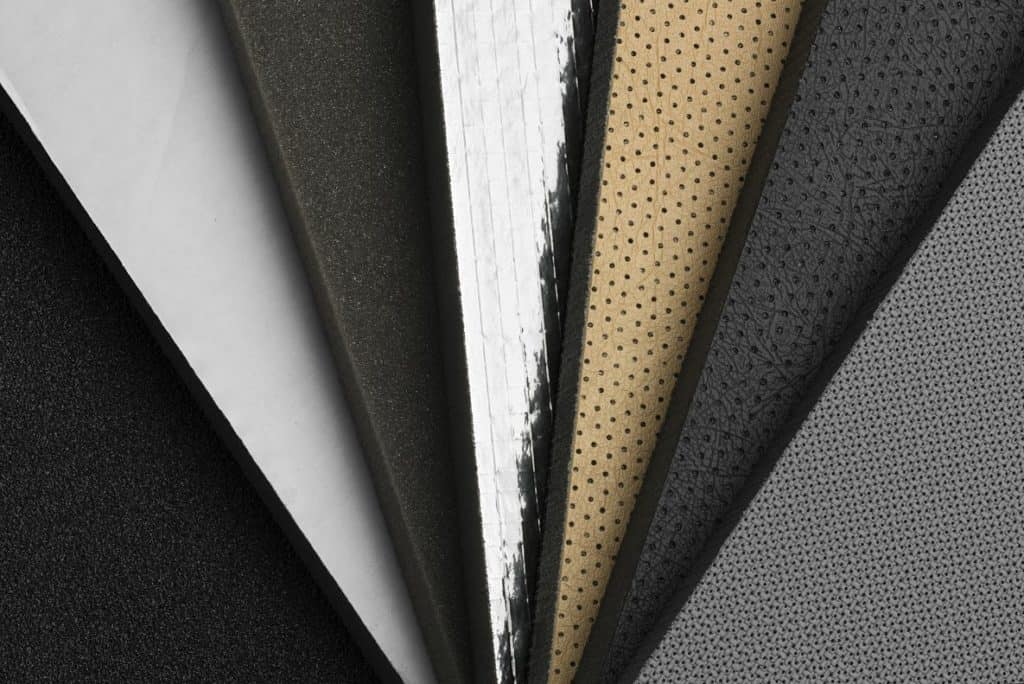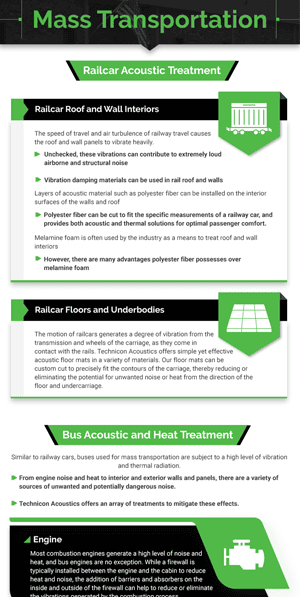When designing mass transportation vehicles and rail, the comfort and safety of passengers and operators is paramount. The high level of noise and heat generated by transportation systems can cause a high level of discomfort if not properly mitigated. Fortunately, there are a number of thermal and sound insulation solutions available to reduce, block, and absorb unwanted heat and vibrational noise.
At Technicon Acoustics, we offer an extensive range of insulation products and solutions for mass transportation applications. We work closely with OEMs and engineers to incorporate acoustic and thermal insulation directly into the design of mass transit vehicles. In addition, we are pleased to offer consulting services to help you find the best noise and vibration reduction options for existing equipment.
Acoustic and Thermal Treatments for Rail, Buses, and Mass Transit
Rail, bus, and other forms of mass transit can cause extremely high vibrational noise, both from the engines and force of movement. Exposure to these levels of noise without proper insulation can cause hearing damage, stress, and disorientation in passengers and operators alike. To reduce the amount of noise exposure, mass transit OEMs and designers must be able to identify both internal and external sources of noise and address them. At Technicon Acoustics, we have the knowledge and experience to create acoustic and thermal solutions tailored to meet the specific needs of your transportation application.
Railcar Acoustic Treatment
Railcars are exposed to extremely high levels of turbulence and vibration caused by the speed at which they operate. The vibrations from airborne turbulence and contact with the rails easily radiates into the cars via the roof and wall panels and the floor and underbody of the car. Technicon Acoustics has a variety of solutions available for these particular issues.
Roof and Wall Interiors
The speed of travel and air turbulence of railway travel causes the roof and wall panels to vibrate heavily. Unchecked, these vibrations can contribute to extremely loud airborne and structural noise. Vibration damping materials can be used in rail roof and walls.
Layers of acoustic material such as polyester fiber can be installed on the interior surfaces of the walls and roof. Polyester fiber can be cut to fit the specific measurements of a railway car, and provides both acoustic and thermal solutions for optimal passenger comfort.
Melamine foam is often used by the industry as a means to treat roof and wall interiors. However, there are many advantages polyester fiber possesses over melamine foam.
You May Also Like: Polyester Fiber vs. Melamine Foam: Which Is the Better Option?
Roof Interiors, Wall Interiors, Doors: Vibration Damping
The speed of travel and air turbulence of railway travel causes the roof and wall panels to vibrate heavily. Unchecked, these vibrations can contribute to extremely loud airborne and structural noise. Vibration damping materials can be used in rail roof and walls.
Roof Interiors, Wall Interiors, Doors: Acoustic Solutions
Layers of acoustic material such as polyester fiber can be installed on the interior surfaces of the walls and roof. Polyester fiber can be cut to fit the specific measurements of a railway car, and provides both acoustic and thermal solutions for optimal passenger comfort.
Melamine foam is often used by the industry as a means to treat roof and wall interiors. However, there are many advantages polyester fiber possesses over melamine foam.
Floors and Underbodies

The motion of railcars generates a degree of vibration from the transmission and wheels of the carriage, as they come in contact with the rails. Technicon Acoustics offers simple yet effective acoustic floor mats in a variety of materials. Our floor mats can be custom cut to precisely fit the contours of the carriage, thereby reducing or eliminating the potential for unwanted noise or heat from the direction of the floor and undercarriage.
For more detail to these specific solutions, check out the below infographic and click each section for more information!
Floors and Underbodies
The motion of railcars generates a degree of vibration from the transmission and wheels of the carriage, as they come in contact with the rails. Technicon Acoustics offers simple yet effective acoustic floor mats in a variety of materials. Our floor mats can be custom cut to precisely fit the contours of the carriage, thereby reducing or eliminating the potential for unwanted noise or heat from the direction of the floor and undercarriage.
Bus Acoustic and Heat Treatment
Similar to railway cars, buses used for mass transportation are subject to a high level of vibration and thermal radiation. From engine noise and heat to interior and exterior walls and panels, there are a variety of sources of unwanted and potentially dangerous noise. Technicon Acoustics offers an array of treatments to mitigate these effects.
Engine
Most combustion engines generate a high level of noise and heat, and bus engines are no exception. While a firewall is typically installed between the engine and the cabin to reduce heat and noise, the addition of barriers and absorbers on the inside and outside of the firewall can help to reduce or eliminate the vibrations generated by the combustion process.
Floors
The noise generated by the tires of a large vehicle on the road can be extreme. Vibration can easily travel from the tires through the suspension system into the cab, creating a great deal of unwanted structural and airborne noise. To mitigate the sound, Technicon’s experts will often incorporate a mass loaded vinyl (MLV) sound barrier into the floor system of the bus. The barrier can be tailored to meet the functional and aesthetic needs of the system for ideal passenger safety and enjoyment.
Passenger Cabins
To reduce the amount of noise that travels from the driver’s cab to the passenger area of the bus, it is important to add sound absorbing materials to reduce the amount of airborne noise. Sound absorbing panels can also be installed between the interior panels and exterior frame to provide additional thermal insulation for enhanced interior comfort.
Body Panels
Similar to railway cars, the exterior panels of buses are subject to high levels of vibration from wind velocity, road vibration, and engine noise. The structural and airborne sound produced by these factors can be deafening. At Technicon Acoustics, we offer a selection of vibration damping materials that can be installed on vertical and horizontal surfaces along the walls and roof of the bus carriage. With easy pressure-sensitive application, you can ensure the comfort of your passengers through quick and easy barrier material installation.
Thermal and Acoustic Insulation Solutions From Technicon Acoustics
At Technicon Acoustics, we are dedicated to providing thermal and acoustic insulation solutions specifically tailored to the needs of your application. Our extensive understanding of the science of acoustic vibration and thermal radiation allows us to provide customized solutions for even the most complex applications. To learn more about ways that our insulation products and services can improve your mass transportation applications, contact us today or request a quote.


